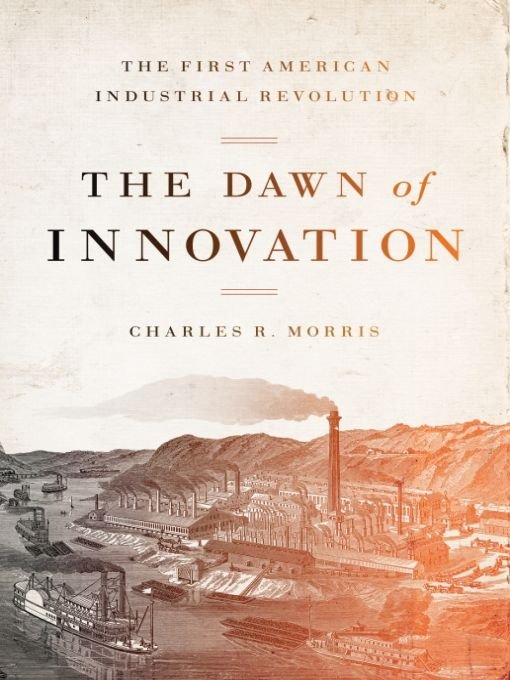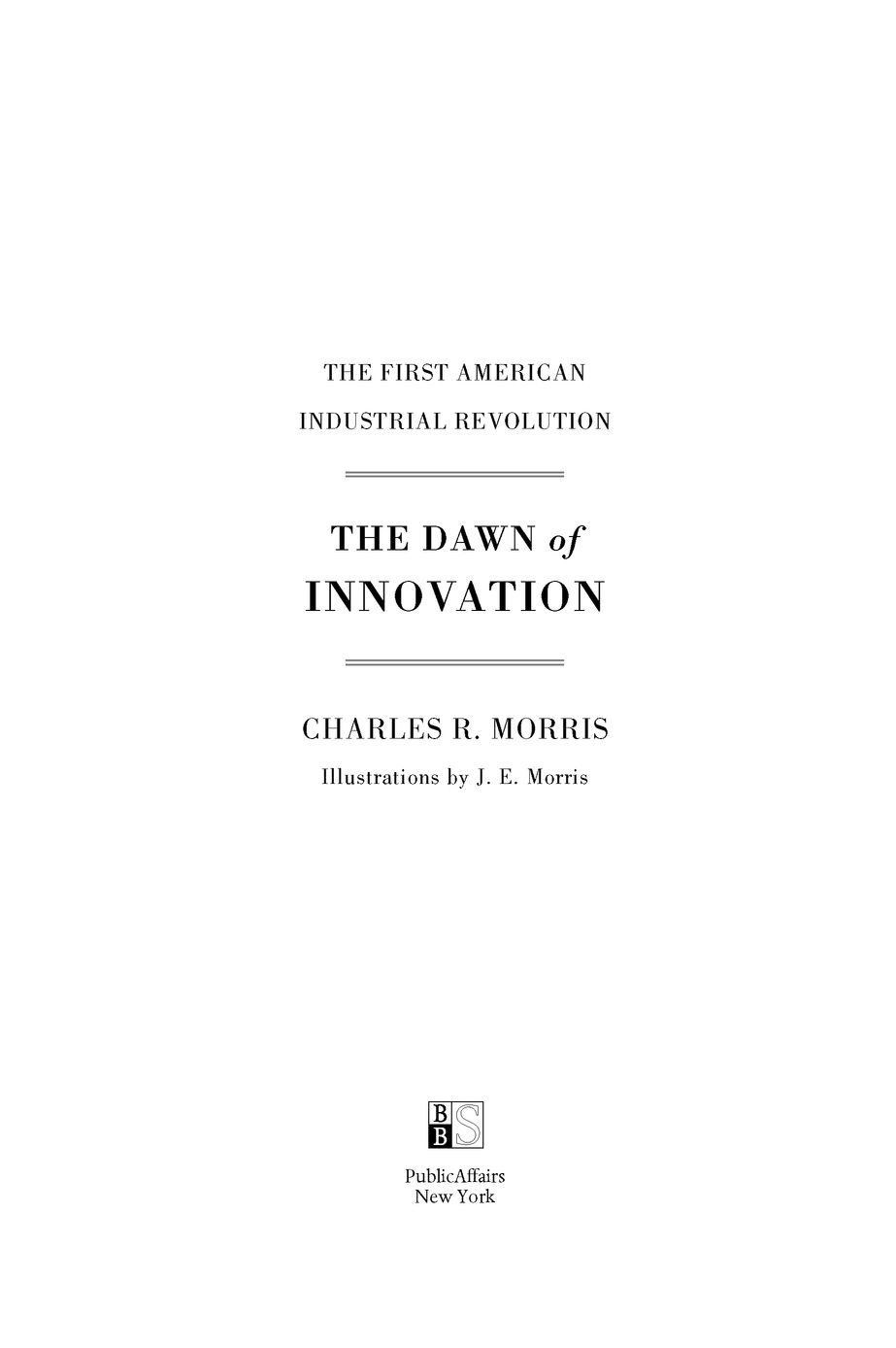The Dawn of Innovation
Read The Dawn of Innovation Online
Authors: Charles R. Morris



Table of Contents
Â
Â
Â
Â
Â
Â
Â
Â
Â
Â
Â
ALSO BY
CHARLES R. MORRIS
CHARLES R. MORRIS
The Sages : Warren Buffett, George Soros, Paul Volcker, and the Maelstrom of Markets
The Trillion Dollar Meltdown: Easy Money, High Rollers, and the Great Credit Crash
The Surgeons: Life and Death in a Top Heart Center
The Tycoons: How Andrew Carnegie, John D. Rockefeller, Jay Gould, and J. P. Morgan Invented the American Supereconomy
Money, Greed, and Risk : Why Financial Crises and Crashes Happen
American Catholic: The Saints and Sinners Who Built America's Most Powerful Church
The AARP: America's Most Powerful Lobby and the Clash of Generations
Computer Wars: The Fall of IBM and the Future of Global Technology
The Coming Global Boom: How to Benefit Now from Tomorrow's Dynamic World Economy
Iron Destinies, Lost Opportunities: The Arms Race Between the United States and the Soviet Union, 1945â1987
A Time of Passion: America, 1960â1980
The Cost of Good Intentions: New York City and the Liberal Experiment, 1960â1975
To Bob Gordon and Carolyn Cooper, scholars and gentlepersons
INTRODUCTION
T
HREE STUPENDOUS AND STRONGLY REINFORCING INNOVATIONS IN POLITICS, in the economy, and in social relations took place in the United States in the 1820s and 1830s. Universal white male suffrage came into effect throughout the country, with voter turnouts routinely in the 80 percent range and a wide range of offices subject to the ballot. The American penchant for mechanized, large-scale production spread throughout industry, presaging the world's first mass-consumption economy. Finally, political and economic power shifted decisively away from society's traditional elites, as the world's first true middle class seized control of the political apparatus. The archetypal American was almost a new species, literate and numerate, shrewd and confident, an unvarnished striver, swimming through a delightful chaos where money and opportunity were for the grasping on every side. As the United States became the world's dominant power in the twentieth century, that model of society, albeit much adapted and trammeled, became the norm in advanced countries.
HREE STUPENDOUS AND STRONGLY REINFORCING INNOVATIONS IN POLITICS, in the economy, and in social relations took place in the United States in the 1820s and 1830s. Universal white male suffrage came into effect throughout the country, with voter turnouts routinely in the 80 percent range and a wide range of offices subject to the ballot. The American penchant for mechanized, large-scale production spread throughout industry, presaging the world's first mass-consumption economy. Finally, political and economic power shifted decisively away from society's traditional elites, as the world's first true middle class seized control of the political apparatus. The archetypal American was almost a new species, literate and numerate, shrewd and confident, an unvarnished striver, swimming through a delightful chaos where money and opportunity were for the grasping on every side. As the United States became the world's dominant power in the twentieth century, that model of society, albeit much adapted and trammeled, became the norm in advanced countries.
The political and cultural threads of this story have been unraveled many times, most recently in Gordon Wood's splendid
Empire of Liberty
. I will concentrate on the nitty-gritty of the economic transformationâthe details of the machinery, the technologies, and the new processes and work organizations that underlay America's stunning record of growth. But the evolution of the country's politics and class relations was an essential backdrop for its economic success, so I try to keep those developments in sight at every point.
Empire of Liberty
. I will concentrate on the nitty-gritty of the economic transformationâthe details of the machinery, the technologies, and the new processes and work organizations that underlay America's stunning record of growth. But the evolution of the country's politics and class relations was an essential backdrop for its economic success, so I try to keep those developments in sight at every point.
Some years ago, I wrote a book called
The Tycoons
, which told the story of how the United States, within just the three decades or so after the Civil War, blew past Great Britain and became the number one economic power in the world. I was drawn to that era because of the outsized characters, the John Rockefellers, the Andrew Carnegies, the Jay Goulds, the J. P. Morgans, who helped channel and shape the development of the new behemoth rising on the American continent.
The Tycoons
, which told the story of how the United States, within just the three decades or so after the Civil War, blew past Great Britain and became the number one economic power in the world. I was drawn to that era because of the outsized characters, the John Rockefellers, the Andrew Carnegies, the Jay Goulds, the J. P. Morgans, who helped channel and shape the development of the new behemoth rising on the American continent.
But the tycoons were not starting from scratch. If they had never lived, the course of American industrialization would certainly have been different, but the long American boom would have happened anyway and on roughly the same scale. The country was just too productive, too entrepreneurial, too inventive, too
original
not to burst into the front rank of world powers, almost regardless of its leadership.
original
not to burst into the front rank of world powers, almost regardless of its leadership.
The Dawn of Innovation
therefore takes the story back to the beginning of the century, when the country started building the economic platform that launched the astonishing industrial development in the decades after the Civil War.
therefore takes the story back to the beginning of the century, when the country started building the economic platform that launched the astonishing industrial development in the decades after the Civil War.
I use two main thematic hooks to organize the story. First, I frame it as an implicit competition between America and Great Britain. That is the way most Americans viewed it after the old federalists like Alexander Hamilton and John Adams passed from the scene. After the Revolution, British opinion still treated the United States as a pseudo-colony, and the War of 1812 had Americans once again fighting British troops on American soil. As French and Spanish power faded, only the British stood in the way of American continental ambitions, and it was no secret that British sympathies were with the disunionists during the Civil War. Even Hamilton, a great admirer of the British system, mused that the United States might well be its equal within forty or fifty years, which wasn't far off the mark.
The second theme is to argue for a broader definition of what came to be called the American system of manufacturing. That was the name the British applied to the American machinery-intensive methods of manufacturing guns. “Armory practice” is a more appropriate designation, for while it is an important thread of American developmentâculminating in
the great twentieth-century automobile plantsâduring most of the nineteenth century it applied only to a narrow range of industrial output.
the great twentieth-century automobile plantsâduring most of the nineteenth century it applied only to a narrow range of industrial output.
There was indeed a distinctly American approach to manufacturing in the nineteenth century: it was the drive to mass production and mass distribution in every fieldâfrom foodstuffs to soap and candles, axes and locomotives, horseshoes, wooden doors, carriage wheels, bedroom furniture, and almost anything else. The nature of the machinery and the underlying technologies varied from product to productâsoap making was different from steelmaking, and neither had much in common with making guns or clocks. And sometimes, American mass production was all about organization, not machinery, as in the antebellum shoe industry. It was the uniquely American penchant for scale and speed that ultimately created the mass-consumption economy. Mass consumption, the rise of a successful middle class, and a democratized government were all part of the package that was the great American experiment.
The Plan of the BookI open with a little-known tale from the War of 1812, the shipbuilders' war on Lake Ontario. Both sides understood that controlling the lake was key to winning the war, and asymmetries in the two sides' armaments and tactics led to a classic arms race. Absurdly, by war's end the lake was home to some of the largest and most formidably armed warships in the world. Both sides' supply systems were pushed to the point of exhaustion, but the effort played a big role in jump-starting American industrialization.
The next chapter focuses on Great Britain, the nineteenth century's hyperpower. Its technical and scientific breakthroughs were the critical substrate for American progress. The British also invented mass production in their great textile industries but were amazed to discover in mid-century that the Americans were applying the same concepts across almost the whole of industry.
The story of American development can be charted as an evolution from local to regional and finally to national networks. Strong regional economies emerged in the Northeast in the first quarter of the century. By
the 1820s, rural New England and the Middle Atlantic region were hotbeds of industrialization, with farms and forges working cheek by jowl and the self-subsistent farm family already an anachronism. Industries like clocks, cloth, shoes, and cast-iron stoves were achieving seaboard-wide markets. I also devote a full chapter to the development of the armory practice of the Connecticut River Valley and the great inventors who pioneered precision machine manufacturing. Important names in the immediate postwar period are Eli Terry and Chauncey Jerome, the Holleys, Oliver Evans, Francis Cabot Lowell and Paul Moody, Thomas Blanchard and John Hall.
the 1820s, rural New England and the Middle Atlantic region were hotbeds of industrialization, with farms and forges working cheek by jowl and the self-subsistent farm family already an anachronism. Industries like clocks, cloth, shoes, and cast-iron stoves were achieving seaboard-wide markets. I also devote a full chapter to the development of the armory practice of the Connecticut River Valley and the great inventors who pioneered precision machine manufacturing. Important names in the immediate postwar period are Eli Terry and Chauncey Jerome, the Holleys, Oliver Evans, Francis Cabot Lowell and Paul Moody, Thomas Blanchard and John Hall.
In the 1820s and 1830s, the “West” signified the area bounded by the western slopes of the Appalachians and the eastern shores of the Mississippi. Since interior transportation was virtually nil, there evolved a pellet economy of little self-sufficient towns clustered on riverbanks. The breakthrough was the development of the western steamboat by Henry Shreve and Daniel French. It was a cunningly adapted craft that could carry massive loads on shallow, swift water, blithely steaming upstream against rapids.
Within a decade the region's great grain, lumber, and meat animal enterprises were centralizing in Cincinnati, as a tight-knit riverine economy took shape within the Ohio, Missouri, and Mississippi valleys. Cincinnati invented the meatpacking “disassembly” line later made famous by Chicago, and Cincinnati brothers-in-law Procter and Gamble were innovators in America's first chemical industry. Cincinnati and the West were also a prime subject for the finest American travel writers from this period: Alexis de Tocqueville, Frances Trollope, Harriet Martineau, Charles Dickens, and Lucy Bird.
Other books
Finding Colin Firth: A Novel by March, Mia
War Bringer by Elaine Levine
Maximum Risk by Lowery, Jennifer
Devi's Paradise by Roxane Beaufort
Twelfth Night by William Shakespeare
Farthest Reach by Baker, Richard
A Vampire's Saving Embrace by Kuncytes, Darlene
My Ruthless Prince by Gaelen Foley
The Steam Mole by Dave Freer